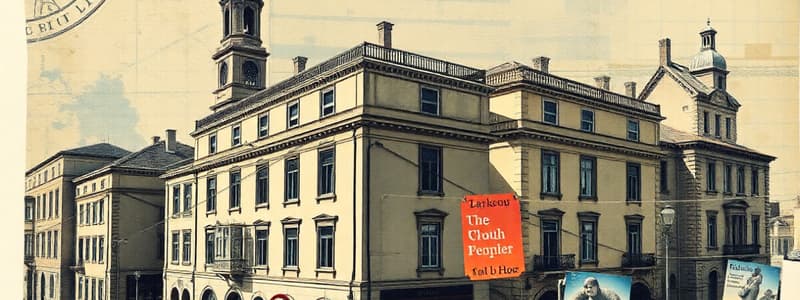Podcast
Questions and Answers
What does architecture primarily represent according to the provided content?
What does architecture primarily represent according to the provided content?
- The design of buildings only
- Engineering principles of construction
- The identification of place (correct)
- Aesthetic appeal of structures
Which of the following best describes the relationship between architecture and place?
Which of the following best describes the relationship between architecture and place?
- Place and architecture are completely interchangeable.
- Place is to architecture as meaning is to language. (correct)
- Architecture dictates the use of a place.
- Architecture is unrelated to place.
Which element is not mentioned as a basic component of architecture in the text?
Which element is not mentioned as a basic component of architecture in the text?
- Walls
- Flooring (correct)
- Columns
- Roof
In the example of the prehistoric family, what is identified as the initial focus of their dwelling?
In the example of the prehistoric family, what is identified as the initial focus of their dwelling?
How does architecture change according to the content provided?
How does architecture change according to the content provided?
What does the content suggest is essential to understanding architecture?
What does the content suggest is essential to understanding architecture?
Which of the following is true regarding the evolution of architecture?
Which of the following is true regarding the evolution of architecture?
Which of the following can serve as a roof?
Which of the following can serve as a roof?
What role does the windshield play in the beach camp scenario described?
What role does the windshield play in the beach camp scenario described?
What is NOT considered a path according to the content?
What is NOT considered a path according to the content?
Which element is primarily determined by the properties of materials?
Which element is primarily determined by the properties of materials?
How can openings in architecture be described?
How can openings in architecture be described?
Which of the following is NOT listed as a modifying element of architecture?
Which of the following is NOT listed as a modifying element of architecture?
What type of support can aid a roof, aside from walls?
What type of support can aid a roof, aside from walls?
What architectural feature is described as a barrier physically but not visually?
What architectural feature is described as a barrier physically but not visually?
What architectural form was designed by Alvar Aalto and Aino in 1939?
What architectural form was designed by Alvar Aalto and Aino in 1939?
What is the primary function of the ground in architecture?
What is the primary function of the ground in architecture?
Which of the following descriptions accurately defines a pit in architectural terms?
Which of the following descriptions accurately defines a pit in architectural terms?
What role does a marker play in architecture?
What role does a marker play in architecture?
What is considered the focus in architectural terms?
What is considered the focus in architectural terms?
Which of the following correctly describes a raised area in architecture?
Which of the following correctly describes a raised area in architecture?
In what way does a roof contribute to architectural design?
In what way does a roof contribute to architectural design?
Which statement about barriers in architecture is correct?
Which statement about barriers in architecture is correct?
What can be considered a characteristic of a defined area of ground?
What can be considered a characteristic of a defined area of ground?
Flashcards
Roof
Roof
A barrier that provides protection from the elements, supported by walls, columns, or posts.
Path
Path
A space that allows movement from one point to another, it may be straight, curved, or inclined.
Glass Wall
Glass Wall
A barrier that lets light pass through, often made of glass.
Doorways and Windows
Doorways and Windows
Signup and view all the flashcards
Suspension Rod or Cable
Suspension Rod or Cable
Signup and view all the flashcards
Modifying Elements of Architecture
Modifying Elements of Architecture
Signup and view all the flashcards
Basic Elements Combined
Basic Elements Combined
Signup and view all the flashcards
Villa Mairea
Villa Mairea
Signup and view all the flashcards
Architecture
Architecture
Signup and view all the flashcards
Place
Place
Signup and view all the flashcards
Basic Elements of Architecture
Basic Elements of Architecture
Signup and view all the flashcards
Identifying Places in a Home
Identifying Places in a Home
Signup and view all the flashcards
Architecture and Language
Architecture and Language
Signup and view all the flashcards
Beach Camp as an Architectural Example
Beach Camp as an Architectural Example
Signup and view all the flashcards
Fireplace
Fireplace
Signup and view all the flashcards
Wall
Wall
Signup and view all the flashcards
Defined Area of Ground
Defined Area of Ground
Signup and view all the flashcards
Raised Platform
Raised Platform
Signup and view all the flashcards
Marker
Marker
Signup and view all the flashcards
Focus
Focus
Signup and view all the flashcards
Barrier
Barrier
Signup and view all the flashcards
Roof or Canopy
Roof or Canopy
Signup and view all the flashcards
Study Notes
Introduction to Architecture
- Identification of Place and Basic Elements of Architecture is the topic
- The presenter is Ar. Diane A. Jose, MBA
- The lecture was presented at EARIST College, since 1989
Architecture as Identification of Place
- A dictionary definition of architecture is 'the design of buildings', but this is an inadequate definition
- Limiting architecture solely to the design of buildings diminishes its true meaning
- Architecture is about creating place, a concept that is fundamental to the identification of a place
- A simple prehistoric example, the setting of a campfire, demonstrates the concept of establishing a place
Architectural Actions and Dwelling Place
- Basic architectural actions of a prehistoric family can be replicated in a modern context
- The fire is the most important feature—it is the focus, cook place
- A windshield provides protection from the wind (privacy from outside forces)
- There is a designated storage space for fuel
- The rear of the place serves as a storage space for food
- These are the basic 'places' of a house, the initial stages of developing a house, even before walls and a roof
Place is to Architecture
- Place and architecture are related like meaning is to language, architecture is rooted in place, and different settings create different architecture
- Architecture changes and evolves as our understanding of place evolves
- Architecture is closely tied to human activity and the construction of places
Basic Elements of Architecture
- Places are identified by a range of basic elements such as ground, walls, platforms
- Columns, roofs, doors
- Includes the area of ground, or raised platform, or pit, or marker, or focus, or barrier, or roof/canopy, or posts/columns, or paths, or openings
Primary Elements of Architecture
- Physical terms of the primary elements include ground as the datum
- The space above ground as the medium that architecture molds
- Other factors like gravity, light, and time
Defined Area of Ground
- The definition of an area of ground forms the foundation of understanding most types of places.
- Its boundaries and size can vary widely.
- It can extend to the horizon and may be non-rectangular or uneven, blending into the environment
Raised or Lowered Areas
- Raised platforms, stages and terraces are examples of raised areas, providing a different level from the ground, for example a stage or terrace
- Pit or excavation of ground surfaces
- A pit can be used for various functions, such as graves, underground structures or even swimming pools.
Marker and Focus
- Markers are points that uniquely identify a location, and are part of the environment
- Landmarks, such as monuments or natural features, act as markers, making a place distinctive
- Focus is the point of concentration or attention in the space. It can be a fireplace, altar, art piece, or even a natural feature like a mountain
Barrier and Roof/Canopy
- A barrier defines a place by separating it from other places—like a fence or hedge or wall
- A roof or canopy shields a defined area from external elements such as sun and rain, and defines its boundaries
- The structural necessity of support for a roof is essential, this can be provided by walls, columns and posts
Posts/Columns and Paths
- Posts and columns often serve as supports for the roof or canopy
- Paths establish connections between different parts of a space or places, they can be straight, winding, or irregular paths
- They help in navigating and joining different places and spaces
Openings
- Openings like doorways and windows allow passage between places and connect people to their surroundings
- Historically, glass walls are a relatively recent architectural element that function as barriers but lack visual blockage
Combined Architectural Forms
- Basic elements combine to form more complex architectural forms
- Forms such as bridges, and enclosures frequently use combinations or have names of their own, like an aedicule
- The temple, a clear illustration of fundamental elements combined
Modifying Elements of Architecture
- Light, color, sounds, temperature, air movement, smells, quality of materials used, scale, effects, and personal experiences are important elements that alter the architecture of a place
- They modify the experience of place by affecting how it is perceived and used
Residential Architecture
- Villa Mairea by Alvar Aalto
Studying That Suits You
Use AI to generate personalized quizzes and flashcards to suit your learning preferences.




